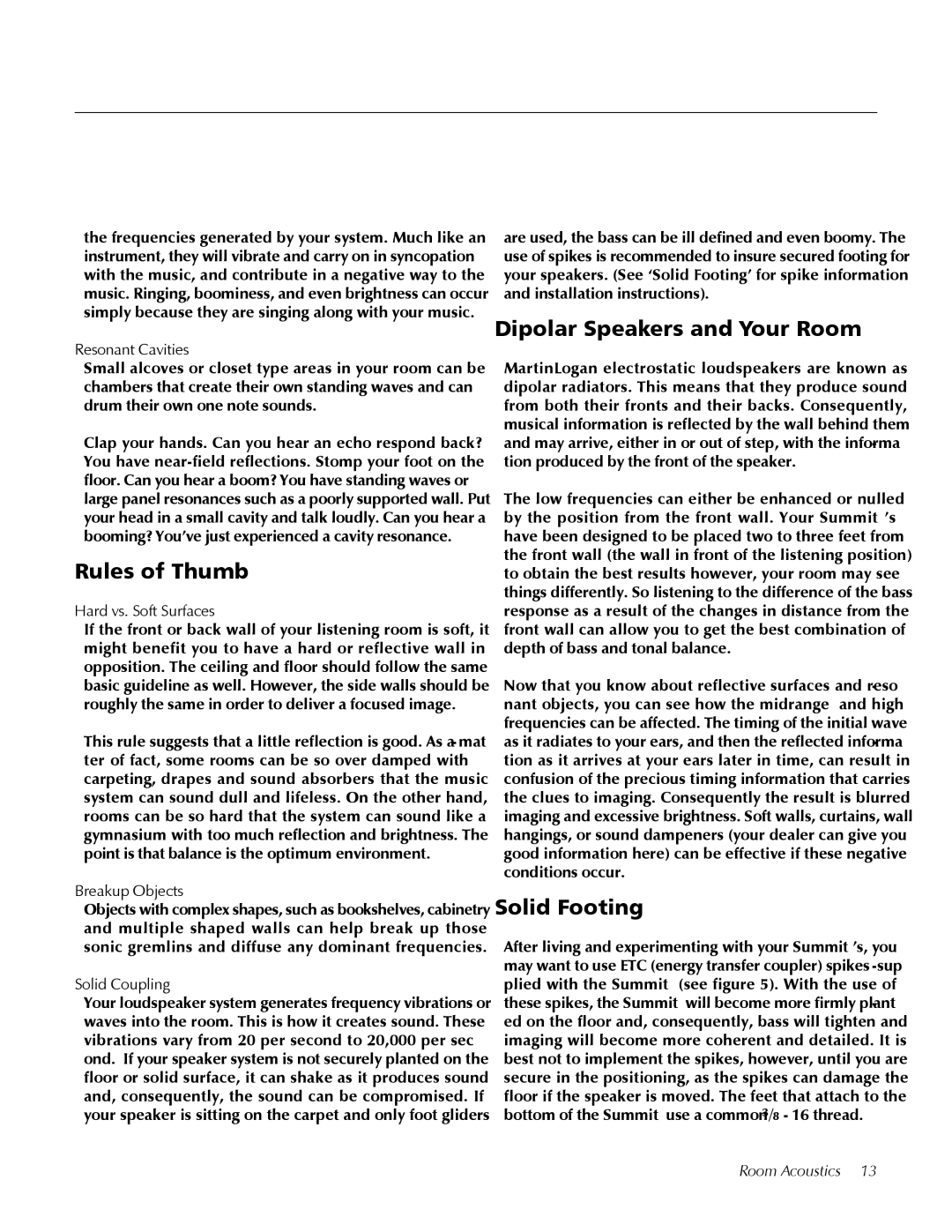the frequencies generated by your system. Much like an instrument, they will vibrate and “carry on” in syncopation with the music, and contribute in a negative way to the music. Ringing, boominess, and even brightness can occur simply because they are “singing along” with your music.
Resonant Cavities
Small alcoves or closet type areas in your room can be chambers that create their own “standing waves” and can drum their own “one note” sounds.
Clap your hands. Can you hear an echo respond back? You have
Rules of Thumb
Hard vs.. Soft Surfaces
If the front or back wall of your listening room is soft, it might benefit you to have a hard or reflective wall in opposition. The ceiling and floor should follow the same basic guideline as well. However, the side walls should be roughly the same in order to deliver a focused image.
This rule suggests that a little reflection is good. As a mat- ter of fact, some rooms can be so “over damped” with carpeting, drapes and sound absorbers that the music system can sound dull and lifeless. On the other hand, rooms can be so hard that the system can sound like a gymnasium with too much reflection and brightness. The point is that balance is the optimum environment.
Breakup Objects
Objects with complex shapes, such as bookshelves, cabinetry and multiple shaped walls can help break up those sonic gremlins and diffuse any dominant frequencies.
Solid Coupling
Your loudspeaker system generates frequency vibrations or waves into the room. This is how it creates sound. These vibrations vary from 20 per second to 20,000 per sec- ond. If your speaker system is not securely planted on the floor or solid surface, it can shake as it produces sound and, consequently, the sound can be compromised. If your speaker is sitting on the carpet and only foot gliders
are used, the bass can be ill defined and even boomy. The use of spikes is recommended to insure secured footing for your speakers. (See ‘Solid Footing’ for spike information and installation instructions).
Dipolar Speakers and Your Room
MartinLogan electrostatic loudspeakers are known as dipolar radiators. This means that they produce sound from both their fronts and their backs. Consequently, musical information is reflected by the wall behind them and may arrive, either in or out of step, with the informa- tion produced by the front of the speaker.
The low frequencies can either be enhanced or nulled by the position from the front wall. Your Summit X’s have been designed to be placed two to three feet from the front wall (the wall in front of the listening position) to obtain the best results; however, your room may see things differently. So listening to the difference of the bass response as a result of the changes in distance from the front wall can allow you to get the best combination of depth of bass and tonal balance.
Now that you know about reflective surfaces and reso- nant objects, you can see how the midrange and high frequencies can be affected. The timing of the initial wave as it radiates to your ears, and then the reflected informa- tion as it arrives at your ears later in time, can result in confusion of the precious timing information that carries the clues to imaging. Consequently the result is blurred imaging and excessive brightness. Soft walls, curtains, wall hangings, or sound dampeners (your dealer can give you good information here) can be effective if these negative conditions occur.
Solid Footing
After living and experimenting with your Summit X’s, you may want to use ETC (energy transfer coupler) spikes sup- plied with the Summit X (see figure 5). With the use of these spikes, the Summit X will become more firmly plant- ed on the floor and, consequently, bass will tighten and imaging will become more coherent and detailed. It is best not to implement the spikes, however, until you are secure in the positioning, as the spikes can damage the floor if the speaker is moved. The feet that attach to the bottom of the Summit X use a common 3/8 - 16 thread.
